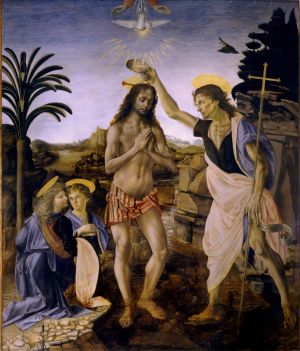Leonardo da Vinci

Leonardo da Vinci (1452-1519), a famous polymath of the Italian Renaissance is often described as a homosexual due to his having not married or had children. While information about his personal life is hard to find, often disparate and obscured by his, and his studio's achievements, Leonardo is best described as a dabbling pederast.
On April 9th, 1476 he was accused of having molested the 17-year-old Jacopo Saltarelli in an anonymous report. Da Vinci was then twenty-three years old and had been a member of the Florence painters' guild for four years. It was tried twice in two months, but there was no testimony or evidence. Through the intercession of the families of the other defendants and Leonardo's friend and teacher Andrea del Verrocchio, the case was dropped on condition that no further allegations were made and the four men were released from prison.
Tween boyfriend?
While we have no idea what the reported 17-year old looked like, Da Vinci's personal relationship shines further light on the matter, as it mirrors almost exactly the model of classical pederasty. His companion and student, Salai (or Salaj), who was actually called Gian Giacomo Caprotti, was the son of the tenant of a winery owned by Leonardo da Vinci just outside of Milan. He came to Leonardo's workshop around 1490 at the age of ten and was employed there as an assistant. He was also available to the master as a nude model. Leonardo is said to have taken such a liking to the ten-year-old male nude model that he adopted him and lived with him for a total of twenty years. Because of Salai's tendency to lie and steal, Leonardo changed his nickname from "Salaino" to "il Salaí" (= the spawn/spawn of the devil) or "mon Salai" in French. According to Vasari (the first Leonardo biographer), Leonardo accepted the boy as his pupil because he liked his "grace and beauty" and his "ruffled curly hair".
Salai stole from Leonardo at least five times - and was still allowed to stay with him. Even in 1497 Da Vinci still states: "Salai steals the money." But apparently he couldn't be angry with the student. Although he played a number of nasty tricks on him and his assistants and even stole money and silver pins and the like from his classmates, he must have proved useful, as is documented for the year 1494, because he was allowed to remain in the workshop. According to Vasari, Leonardo himself taught him "many things in art," and he is said to have revised some of his pupil's work himself.
One thesis, already mentioned by Vasari, is that the name "Mona Lisa" is an anagram of "Mon Salai" (Eng: My Salai). The Mona Lisa you think you know is a woman. However, it seems possible that Salai is actually behind it. The Salai thesis is controversial. It is still advocated by art historians today, but rejected by the Louvre. Italian art historians suspect that a man sat as a model for Leonardo da Vinci's famous painting of the "Mona Lisa". It was likely the artist's student and alleged lover, Salai, according to the head of Italy's cultural heritage committee, Silvano Vinceti. Comparisons of the facial features of the "Mona Lisa" with other paintings by Da Vinci such as "John the Baptist" or "Angel Incarnate" revealed similarities in the nose and mouth areas, which were probably modeled on Salai. In addition, the artist painted the letters "L" like Leonardo and "S" like Salai in the eyes of the "Mona Lisa", said Vinceti.
There is also an imaginary dialogue between Phidias and Leonardo by the Milanese painter Giovanni Paolo Lomazzo from around 1563, in which Leonardo is accused of defending physical love between men (or between men and boys), in which he names Salaj as his lover. In the same dialogue, Leonardo praises Salaj as extremely handsome, with beautiful, wavy hair and well-proportioned mouth and eyes, and describes him as his beloved "pincerna" (Latin cupbearer, alluding to the Ganymedean myth). The direct allusion to a possible sexual relationship can be found in the Codex Atlanticus (a bound collection of drawings, sketches and notes by Leonadro da Vinci).
After the death of Leonardo da Vinci, Salaj inherited half of the winery owned by Da Vinci "for the many loyal and valuable services", moving in until his death. After Leonardo's death, various paintings such as the Mona Lisa remained in the estate, and were administered by Salaj and later acquired by Francis I of France for four thousand gold florins. Salaj died at the age of 44 from an unspecified gunshot and was buried on March 10, 1524 in Milan.
External links and sources
All of the details in this article are corroborated by Wikipedia/external articles in English or German, a vast number of which have been written on different topics relating to Da Vinci and his work. Translation may be necessary.
- Geoutet: Leonardo da Vinci – Genie und Päderast - Background in German (English translation, used to compose this article).
- Welt.de article - In German.
- Salaj - German Wikipedia article.
- Mona Lisa - German Wikipedia article.
- Leonardo da Vinci - German Wikipedia article.
- Personal life of Leonardo da Vinci - By Wikipedia (En).
- Official Encyclopedia
- Gay
- Art
- People
- People: Italian
- People: Deceased
- People: Adult or Minor sexually attracted to or involved with the other
- People: Artists and Poets
- People: Historical minor-attracted figures
- History & Events
- History & Events: Italian
- History & Events: International
- History & Events: 15th C
- History & Events: 16th C
- History & Events: Real Crime
- History & Events: Personal Scandals
- Law/Crime: Corruption